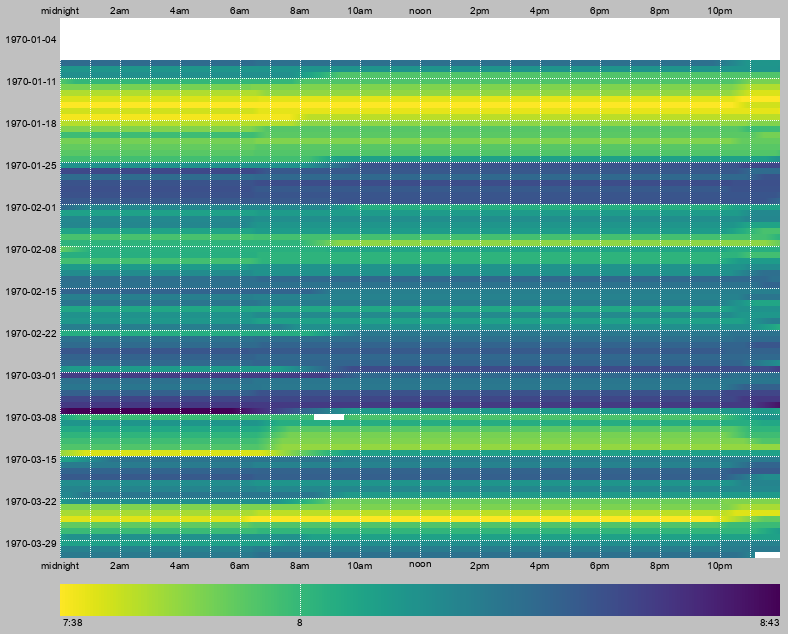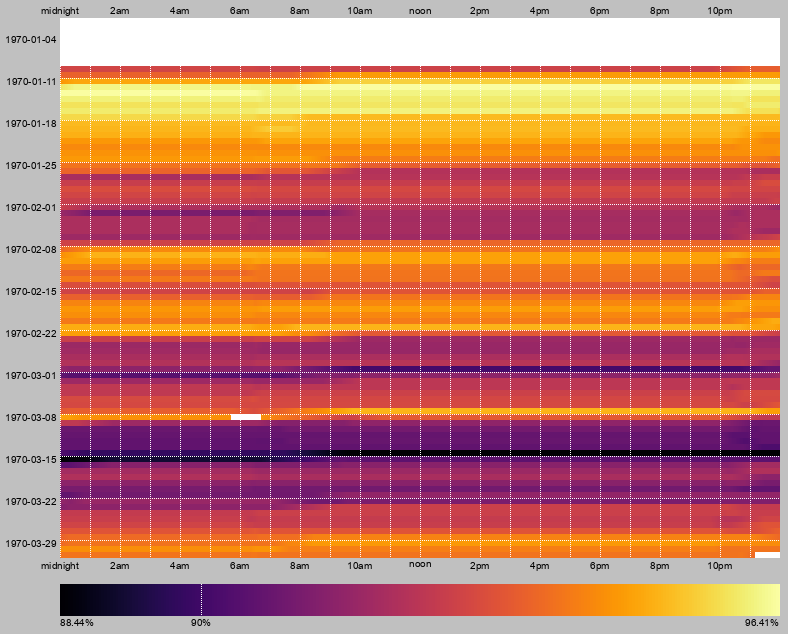A system for controlling lamps from buttons placed strategically around a room (next to your bed, for example), and displaying a history of when they are on and off as a rough proxy for sleep data.
lamps.py runs on a Raspberry Pi, connected to push buttons and an
IoT Power Relay. Pushing a
button toggles the relay and records the event to history.txt.
render.py produces a series of charts based on the history.txt
output by lamps.py.
usage: render.py [-h] [-f MIN] [-lat LAT] [-lon LON] [-tz TZ] outfolder infiles...
options:
-h, --help show this help message and exit
-f MIN, --filter MIN ignore segments shorter than MIN minutes long
files:
outfolder directory to output generated charts and plots
infiles history file(s) to read
sunrise and sunset:
Specify all three of these arguments to add sunrise and sunset markers to the history chart
-lat LAT latitude in degrees north
-lon LON longitude in degrees east
-tz TZ timezone name, e.g., "America/Los_Angeles"
With no files specified, arguments are read from 'input.txt'history.png is a raw representation of when the lamps were on or off. Each
horizontal strip represents one day, from midnight to midnight. The chart has
horizontal gridlines dividing weeks (Sunday-Saturday), and vertical gridlines
dividing hours in each day. The date of each Sunday is labeled on the left side,
as well as every other hour on the top and bottom. White regions represent when
the lamps were on, and black regions when they were off.
This is an example history.png showing 90 days of artificial data:
The trend_*.png files show the same data, but presented differently. The chart
layout is the same as history.png, but the color at each location represents
the average time the lamps have been on per day in the specified previous
interval (1, 7, 14, and 30 days for daily, weekly, fortnightly, and
monthly respectively). The scale at the bottom shows how much time per day
each color represents. Lighter colors mean more time on, and darker colors
mean more time off. Note that the scale is different for each chart.
This is an example trend_weekly.png showing the same 90 days of artificial
data (note the blank space at the top of the chart, because it has not yet been
a week since the start of the data, so there isn't a valid weekly average for
those times):
Cohesion is a measure of how similar the on and off patterns are day-to-day,
or in other words, how consistent your sleep schedule is. The cohesion value for
a given time is calculated by how often, over the pervious interval, the lamp
state (on or off) was the same as it was 24 hours before. 100% cohesion
means that the lamps switch on and off at exactly the same time each day,
and lower values mean lower amounts of overlap over the previous day. Cohesion
values are calculated in rolling windows of 1, 7, 14, and 30 days and ploted in
cohesion_*.png similar to trend values.
This is an example cohesion_weekly.png with 90 days of artificial data:
plots1.png, plots2.png, and plots3.png (and their PDF versions) show
various plots of other information about the data that might be interesting
(though mostly only for real data).
In plots1, the top two are histograms of the time
the lamps are continuously off or on (a "segment"). The bottom two are 2D
histograms of that data over time.
In plots2, the top two show the relationship
between the lengths of adjacent segments (off then on, or on then off).
The middle two show the relationship between a segment's length and the total
time the lamps were off in the 24 hours prior to the segment's start. The
bottom left shows the relationship between the montly trend and the monthly
cohesion.
plots3 shows the "trend" and "cohesion" data as
line graphs.
generate_example.py was used to generate 90 days of
random data in example_history.txt.
example_output/ contains all of the charts based on that
data generated by render.py.
- DST changes result in irregularities for
render.py. The skipped hour in spring shows up as a blank hour after the segment where it actually happened. The script has no way to handle the repeated hour in fall, so some data gets obscured. render.pysplits segments that cross a day boundary (i.e., runs through midnight) into two segments so that it can display them properly, but it assumes that there will never be a segment that crosses more than one day boundary.


